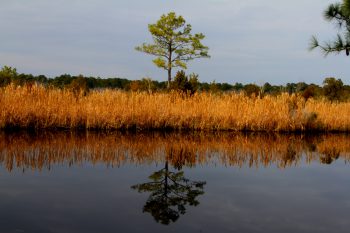The Town of Swansboro Board of Commissioners took proactive steps Tuesday to address stormwater runoff by unanimously voting to adopt a watershed restoration plan developed in partnership with the North Carolina Coastal Federation.

This collaborative effort has been in the works since 2016. The federation has met with town representatives, Hammocks Beach State Park, the White Oak-New Riverkeeper Alliance and local residents over the past few months to develop the plan, which will reduce the volume of runoff that flows into White Oak River and Queens Creek.
Mayor Scott Chadwick was enthusiastic about the adoption of the plan. He said it presents a way for Swansboro to lead by example.
“I think if we make a conscious effort to do this over a period of time, we can improve the water quality,” Chadwick said.
Mariko Polk, GIS watershed specialist with the federation, presented the goals and objectives to the board.
Polk said that the goal of the plan is to “turn back the clock” on water quality issues by decreasing the volume of runoff that enters waterways every year by a targeted 13.3 million gallons. The plan focuses on stormwater infiltration — allowing water to slowly soak into the ground — rather than directing it to waterways.
By using techniques that allow stormwater to filter through the ground, pollutants will also be treated.
The plan addresses ways to reduce runoff from existing properties by installing retrofits on public properties to not only reduce runoff, but educate the public about stormwater and tools to reduce it. The town has also identified voluntary retrofits on private properties as a strategy of the plan.
Lauren Kolodij, deputy director of the federation, said this plan will help position the town to be eligible for future funding to support stormwater projects.
“Towns can install stormwater reduction projects without a watershed restoration plan, but adopting a plan shows that the town is being proactive in addressing its stormwater problems. It sets the town up to better secure funding for stormwater reduction projects,” Kolodij said.
Brent Hatlestad, who is a member of the Planning Board, expressed his support for the plan during the public comment portion of the meeting.
Hatlestad compared his experience of growing up in Swansboro to a “Norman Rockwell painting.” Because he was so fond of his idyllic upbringing in the town, he moved back after he retired. He now lives on the White Oak River Basin and feels strongly about giving back to the community that he said has given him so much.
“If you can’t give back to something your grandkids would enjoy, then something’s wrong,” he said.
A recent river otter sighting reminded him of his passion for protecting water quality.
“I look down in the estuary and there’s this river otter. And I’m thinking, my God, where do you go to see that? People come from all over the United States to Swansboro, Emerald Isle and vacation here for a reason,” Hatlestad said. “And we live here. We’ve got to protect that.”
Many methods for stormwater reduction can be installed right at home. Learn more about these methods in Smart Yards, a guide for simple do-it-yourself stormwater reduction projects at home. To learn more about watershed restoration planning, please visit this page. Please contact Lauren Kolodij at 252-393-8185 for questions about the Swansboro watershed restoration plan.
